BMW unveils Vision Future Luxury car with augmented reality display
German car manufacturer BMW has unveiled Vision Future Luxury, a saloon concept car featuring augmented display technology (+ slideshow).
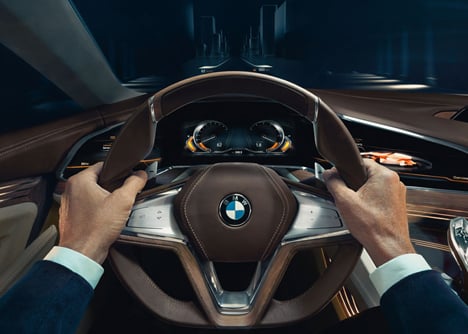
The Vision Future Luxury concept comprises the latest iteration of BMW's Vision Head Up Display, which augments the driver's view of the world by projecting real-time information including speed limits and road signs onto the windscreen directly in the line of sight.
Sensors located on the exterior of the car collect environmental data, which is deciphered and transferred to a light source located inside the instrument panel. Light shining through a translucent thin-film transistor (TFT) projects the relevant data on to the windscreen via specially shaped mirrors and allows the driver to view information without having to look away from the road.
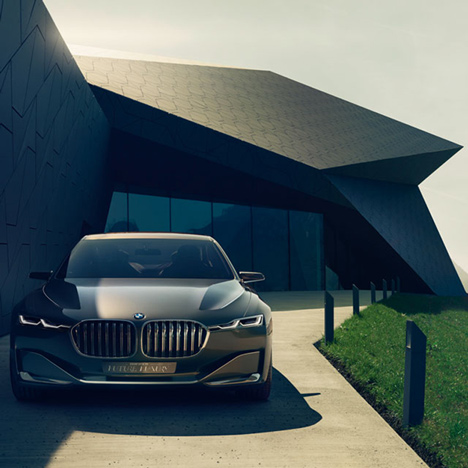
"Innovative technology and modern luxury have always been an important part of BMW's brand DNA," explained Adrian van Hooydonk, Senior Vice President of BMW Group Design at a preview of Vision Future Luxury in Munich. "Connectivity in a luxury vehicle has to be seamless and so well integrated that it doesn't deter from the driving that you want to do, it actually enhances it."
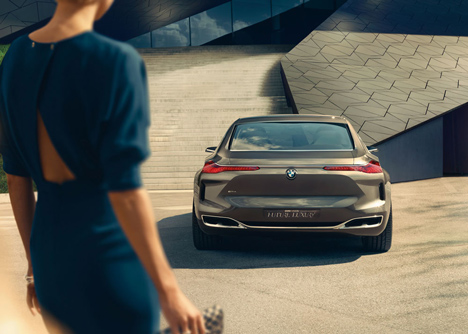
The rear lighting is provided by organic light-emitting diodes (OLEDs) for the first time on a BMW, an efficient light source consisting of wafer-thin semi-conductive layers of organic material that can be cut into any shape to allow for a variety of patterned lighting designs.
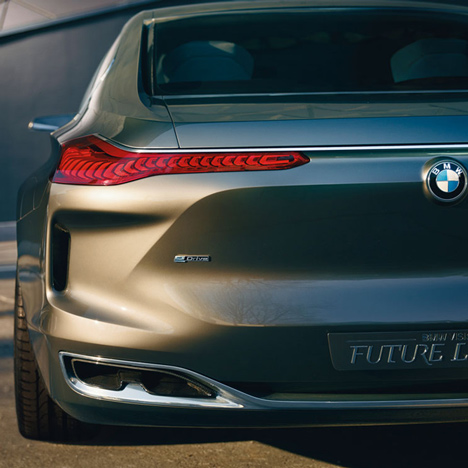
The luminescent layer is a film of carbon compound, which emits light in response to an electrical current. Each light-emitting polymer layer is roughly 400 nanometres thick, which is approximately 400 times thinner than a human hair.
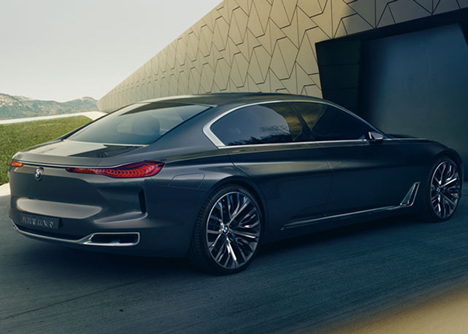
Car designers have previously relied on reflectors to enable the light produced by LEDs to be seen from different angles, but OLEDs do not need reflectors, allowing designers to create less bulky and more unusual shapes. OLEDs also require less power to operate.
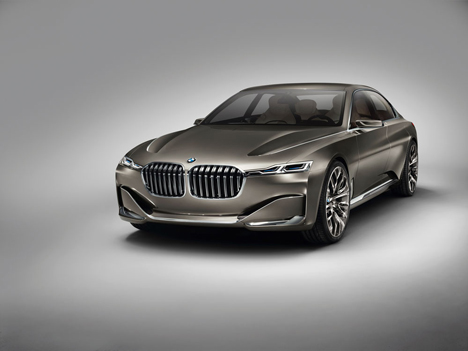
The roofline and sloping boot lid on the car have been designed to reduce drag, while carbon fibre openings positioned at the front and rear of the car help to channel airflow more efficiently.
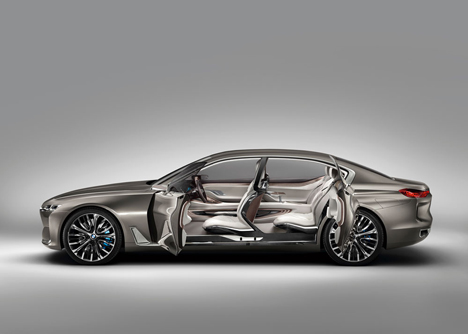
"Aerodynamics and lightweight materials are key elements of this car's design," explained Karim Habib, head of BMW design. "Visible carbon fibre on the exterior of a luxury car is something we believe BMW needs to do."
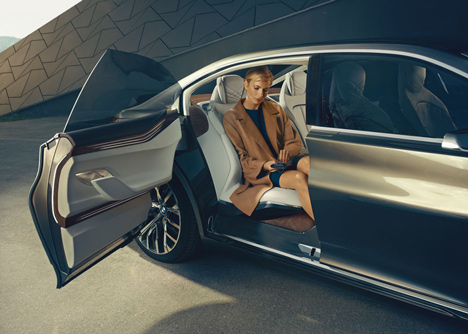
Carbon fibre, as a lightweight and strong composite, also allows for a minimised central B-pillar – the join between the front passenger and rear passenger doors. This allows the doors to use different hinge points to a standard car door.
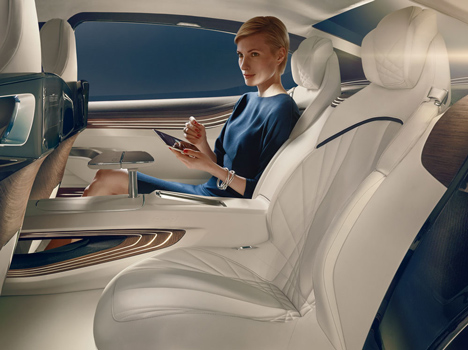
The doors open to reveal a layered interior with wood, leather and aluminium finishings on top of a carbon fibre base.
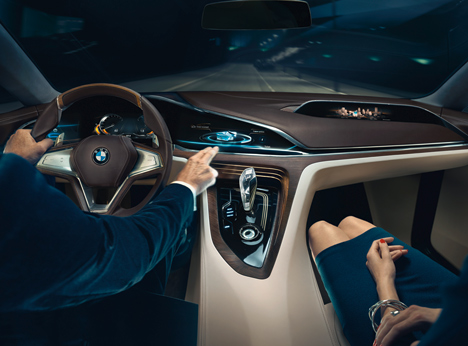
"Lightweight construction is not going to go away," says Adrian van Hooydonk. "All of our cars will have to get lighter and that means as a design team we are dealing with different types of materials, which can lead to different types of aesthetic."
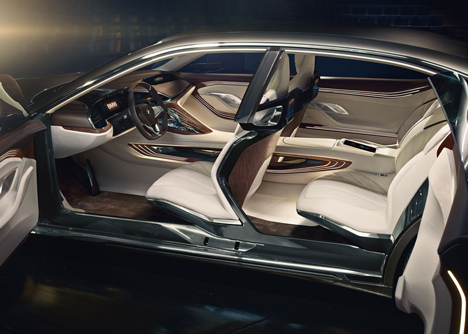
Front passengers are equipped with a personal information display, which is connected to the driver display via a touch-sensitive panel. Rear passengers also have access to two displays mounted in the headrests of the seats in front and a detachable tablet between the individual seats. All three can be used to exchange information with the front passengers using swiping movements.
Embedded user interface components from which internet-based video and music streaming can be accessed also feature.
Read on for BMW's press release:
Heralding a new approach – the design.
"The design of the BMW Vision Future Luxury is the messenger of our philosophy of modern luxury, one in which innovative technologies play a key and vital role. These innovations deliver a new, multifaceted luxury experience that spans intelligent lightweight engineering, innovative interior design and a radically new user interface design," says Karim Habib, Head of BMW Design, summing up the design approach to the BMW Vision Future Luxury.
This approach is particularly tangible in the interior. Throughout, the design expresses both form and function of the innovative technologies. For example, the intelligent lightweight engineering concept of the BMW Vision Future Luxury is expressed in the design principle of subtractive modelling. That is to say, the specific geometry and functions of an individual component are created from one and the same layered composite structure, comprising many different levels and materials. An initial base layer of fine carbon fabric is followed by a functional level featuring user interface components, control and display interfaces and lighting functions, which in turn is followed by a further structural, load-bearing layer of aluminium for additional strength.
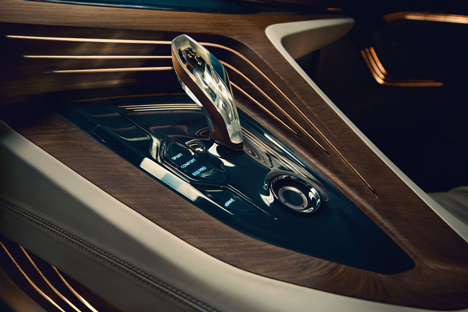
Finally, the top layers comprise wood, then leather, to create a warm and comfortable ambience. In a given area of the interior, the multi-layer structure is "milled down" to the appropriate depth depending on what surface material and what function is required. Since the interior geometry is therefore always pared down to essentials, this cuts total weight substantially. This treatment also makes for virtually seamless transitions and very elegant, fluid surfaces.
The unrivalled characteristics of carbon as a material – both individually and in combination with its surrounding materials – are optimally utilised in this rigorous lightweight design concept. The carbon underlying layer is visible in the doors, under the seats and especially in the innovative, pared-down B-pillar. A full B- pillar as used in the past is dispensed with. The carbon construction allows the seat frames to be integrated into the load-bearing structure. There are also connections to the door sills and centre console, which means only a very small and unobtrusive B-pillar is required. The BMW Vision Future Luxury's wide- opening coach doors would not have been possible without this new carbon B- pillar solution.
New-style user interface design and exclusive
BMW ConnectedDrive services.
In the driver's and front passenger's area, precisely defined lines and surfaces create a sense of exclusive dynamism. The design of the instrument panel closely complements the design of the displays themselves. The driver is surrounded by a wrap-around cluster of three intermeshing displays, creating the typical BMW driver-centric cockpit. The three-dimensional display technology means that at the visual level the instrument panel styling appears to carry over into the displays themselves. In other words, to the eye the interior space seems to continue into the solid structures of the instrument panel, generating an impression of unprecedented depth and spaciousness.
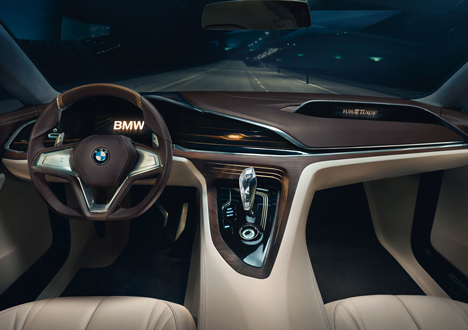
The left-hand display mainly presents vehicle-related information, while in the centre a programmable cluster displays speedometer, rev counter and other information, as well as context-adaptive supplementary data, which is displayed as and when relevant. Meanwhile, the right-hand display – the Driver Information Display – provides additional infotainment information. The driver also has the option of controlling all these functions by voice command.
BMW Vision Head Up Display.
The primary driver display, however, is the “contact-analogue” BMW Vision Head Up Display. This display augments the driver's view of the real world by projecting information directly in the driver's line of sight onto the road. Buildings, traffic signs or hazards can be highlighted directly in the real-world environment, selectively directing the driver's attention to specific information which is particularly important at any given time. This technology gives a new dimension to driver assistance functions such as Speed Limit Info, where road signs can be identified and highlighted in the driver's field of view, or the Traffic Light Assistant, which provides real-time information about traffic light phasing.
In place of a central shared information display for driver and front passenger, the BMW Vision Future Luxury offers front passengers their own Passenger Information Display. This display is connected to the Driver Information Display via a touch-sensitive panel, where information can be exchanged between driver and front passenger using swiping movements. Applications like booking opera tickets online direct from the vehicle via the BMW ConnectedDrive Luxury Concierge service can be displayed in the Passenger Information Display, where they don't risk distracting the driver. The relevant functions can be conveniently controlled by the front passenger using the iDrive Controller with touch-sensitive interface.
Rear Seat Touch Command Tablet.
In the back, two Rear Seat Displays set into carbon surrounds, and a detachable Rear Seat Touch Command Tablet, put the finishing touch to the integrated user interface concept of the BMW Vision Future Luxury. These displays can communicate with the front displays and also with the BMW ConnectedDrive services. Everything from trip-related information like speed and journey time to information relating to the Luxury Concierge Services can be displayed here in simple and customised form.
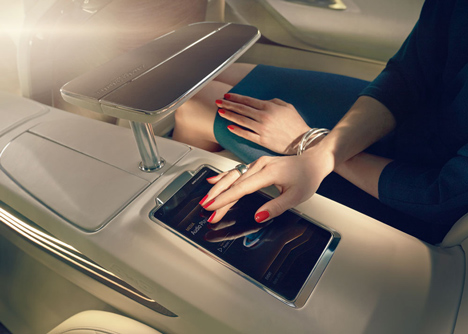
It is also possible to use online entertainment content like internet-based video and music streaming as well as gaming. All content and functions can be controlled from the rear seats using the detachable Rear Seat Touch Command Tablet in the centre console.
Personal space at the rear.
For the occupants of the rear seats, the BMW Vision Future Luxury offers a luxurious haven of personal space. Two large, deeply contoured single seats add to the appeal, inviting passengers to retire into their own personal "comfort zone". A retractable table, the angled Rear Seat Displays and the rigid backs of the front seats create a very private ambience, sectioning this area off from the rest of the interior. The sense of privacy is accentuated by modern, flowing geometry and the use of select materials, with lavish wood surfaces extending from the rear parcel shelf to enfold the rear seat occupants in a cosseting three- dimensional space.
Strategically placed lighting slats integrated into the wood echo the surrounding styling and, with their warm glow, accentuate the modern and cosy ambience. Finest-quality aniline leather in Batavia brown and a lighter Silk shade, Silk nubuk leather and the warm brown, layered lime wood all have a natural aura which offers unique visual appeal and quality. The division between darker materials in the upper areas and light materials in the lower areas creates a feeling of warmth and a luxurious sense of space. A deep-pile pure silk carpet rounds off the exclusive array of materials in the interior of the BMW Vision Future Luxury.
Exclusiveness and elegance – the exterior design.
In side view, perfect proportions – precise, uncluttered and elegant – convey the exclusiveness of the BMW Vision Future Luxury. The long wheelbase, short overhangs and low, set-back greenhouse lend the stretched silhouette a refined dynamism. In hallmark BMW style, a finely sculpted contour line creates a taut arc along the side of the vehicle, and the opulent surfaces underneath this line have, as always on a BMW, been shaped by seasoned modellers. This hand- sculpted design gives the surfaces a special emotional appeal that would be beyond the capabilities of a computer.
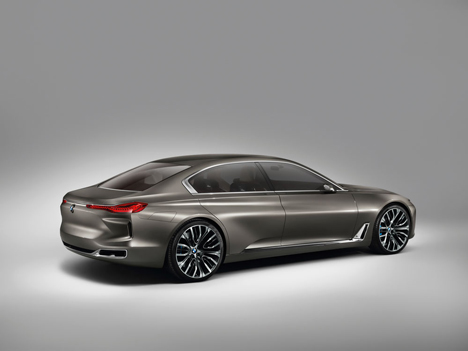
The effect is further enhanced by the Liquid Platinum Bronze exterior paintwork, which generates a warm, shimmering effect. An exclusive flourish at the side of the vehicle is the side mirror, which appears to grow organically out of the chrome window trim. Designed as a visual continuation of the chrome trim, its slender stalk is attached to the mirror from below, giving it a graceful and effortless appearance, almost as if it were hovering in mid-air.
BMW EfficientDynamics: honed aerodynamics and intelligent lightweight engineering.
The exterior design perfectly showcases the advanced aerodynamics and innovative lightweight engineering of the BMW Vision Future Luxury. The coupé- style roofline and sloping boot lid, for example, significantly reduce drag. Underlying the tautly sculpted exterior surfaces, equally refined solutions provide optimal channelling of the airflow. They include the Air Breather system at the rear of the front wheel arch, a C-pillar with internal air channelling, and openings in the rear apron which vent air from the wheel arches. An elegant carbon strip in the door sill area alludes discreetly to the innovative lightweight engineering concept based on aluminium and carbon. Both these lightweight materials are used in the vehicle in exactly the right places to achieve maximum effect – both individually and in tandem.
BMW Laserlight at the front.
Clean and simple in design, the traditional iconic BMW front-end design cues – the twin kidney grille and twin headlights – instantly proclaim the brand identity of the BMW Vision Future Luxury. The lean contours of the headlights also hint at the innovative technology sheltering behind them: BMW Laserlight. This new technology not only paves the way for a very flat and dynamic interpretation of the typical BMW twin round headlamps, it also sets completely new standards in terms of brightness, range and intensity. The concentrated, parallel light beam is up to ten times more intense than that of an LED system. The reduced energy consumption and packaging requirements of laser lights make this technology a prime candidate for use in future vehicles.
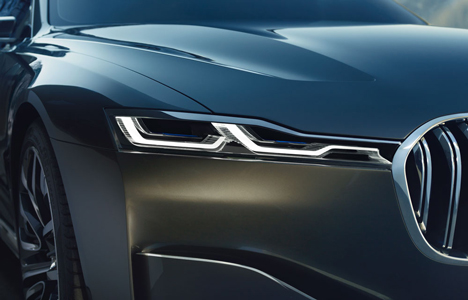
Underneath the headlights, the assertive multi-material front apron accentuates the elegant front-end styling. At the outboard ends of the apron, graceful carbon air deflectors conceal a range of BMW EfficientDynamics aerodynamics features. The thin-walled air deflectors are made of carbon, a further reminder of the intelligent lightweight engineering concept of the BMW Vision Future Luxury. A slender chrome strip on the air deflectors highlights the airflow system.
OLED lighting at the rear.
The horizontal lines of the side profile glide gently away at the rear in a final expansive flourish. As at the front, the body styling in this area is deliberately understated, allowing the innovative, narrow and slender lights to make a powerful statement. For the first time on a BMW the rear lighting is provided by organic LEDs, paving the way for a completely new treatment of the typical BMW L-shaped lights. The BMW Vision Future Luxury's L-shaped rear lights comprise a large number of small, likewise L-shaped OLEDs.
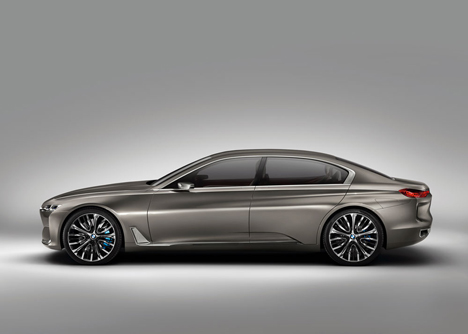
An organic LED consists of wafer-thin organic semiconductor layers positioned between two electrodes. The light-emitting polymer layer is only approx. 400 nanometres thick, making it roughly 400 times thinner than a human hair. Organic LEDs are not only extremely thin, as well as flexible, they also produce very uniform illumination over their entire surface. Due to their very thin dimensions, and since they do not require reflectors in order to produce the desired broad light dispersion, they open up completely new ways of using light in and around the vehicle.